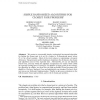562 search results - page 1 / 113 » Simple Randomized Algorithms for Closest Pair Problems |
CCCG
1993
14 years 7 months ago
1993
SIAMCOMP
1998
14 years 5 months ago
1998
We describe a new randomized data structure, the sparse partition, for solving the dynamic closest-pair problem. Using this data structure the closest pair of a set of n points in ...
CORR
2008
Springer
14 years 6 months ago
2008
Springer
One way to find closest pairs in large datasets is to use hash functions [6], [12]. In recent years locality-sensitive hash functions for various metrics have been given: projecti...
SIGMOD
2000
ACM
14 years 10 months ago
2000
ACM
This paper addresses the problem of finding the K closest pairs between two spatial data sets, where each set is stored in a structure belonging in the R-tree family. Five diffe...
SODA
1998
ACM
14 years 7 months ago
1998
ACM
We develop data structures for dynamic closest pair problems with arbitrary (not necessarily geometric) distance functions, based on a technique previously used by the author for ...


